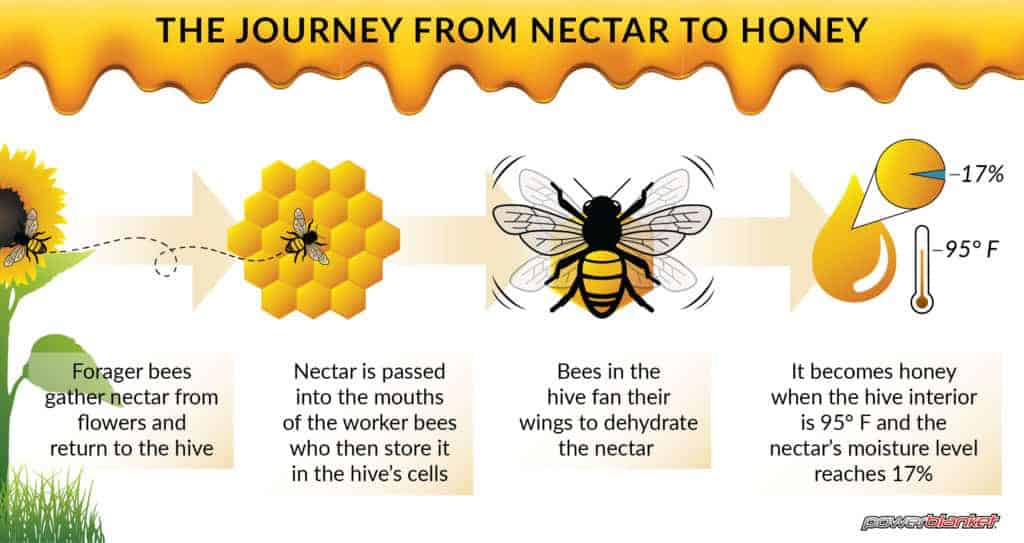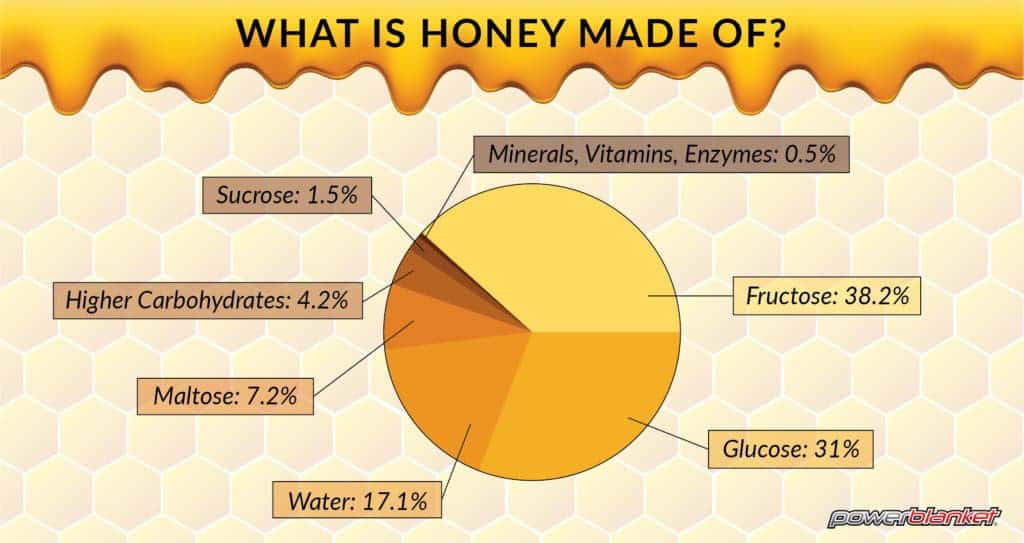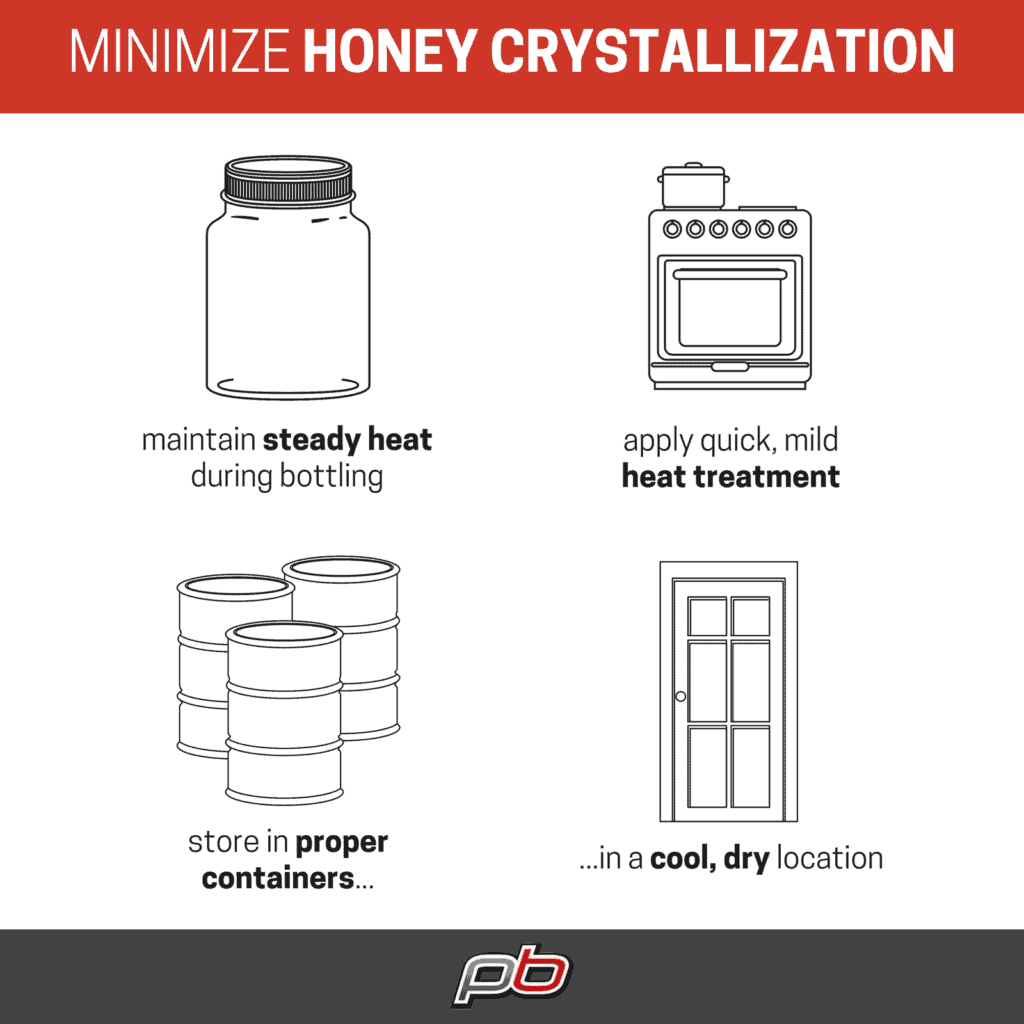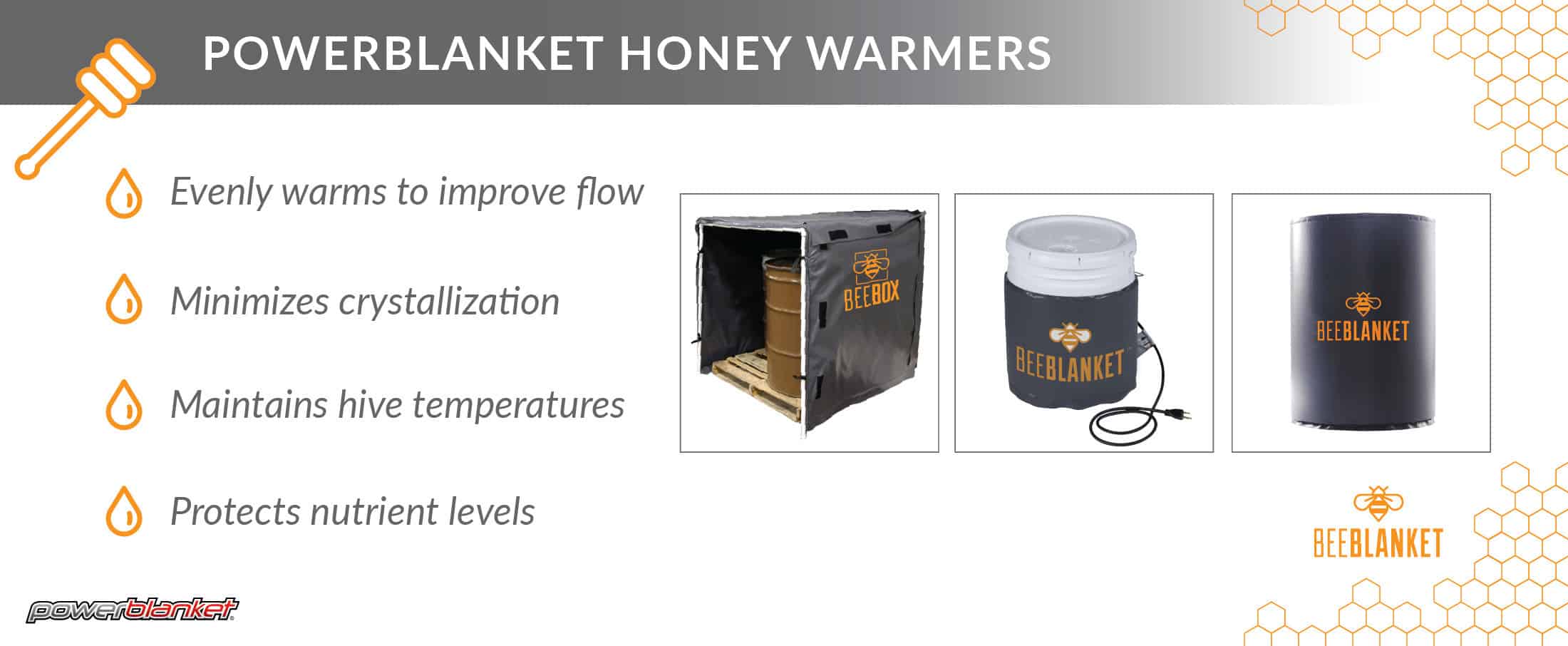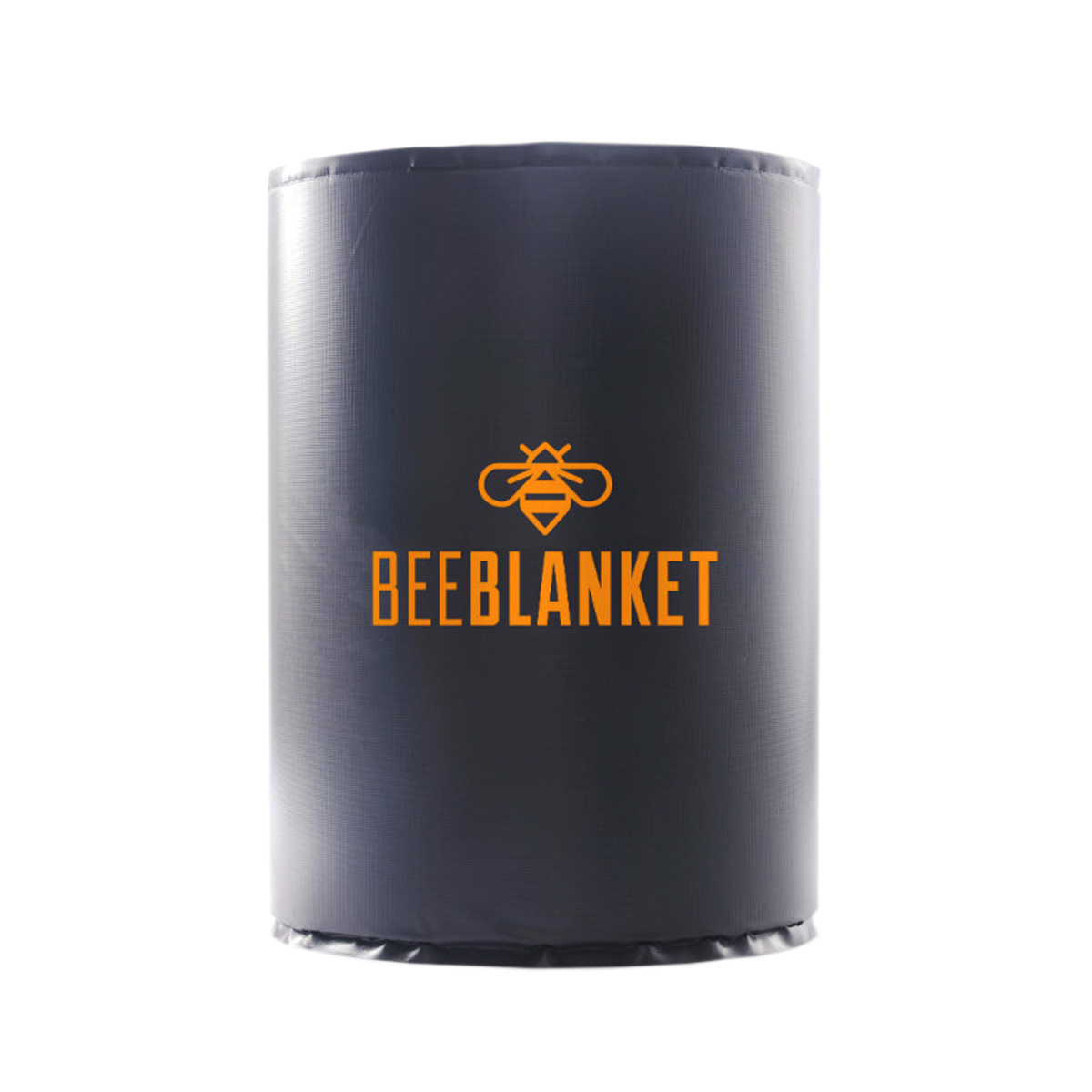There’s a reason that we use “honey” as a term of endearment. As a naturally occurring substance, it is one of the most precious. The Powerblanket Bee Blanket eases all of the stress and concerns related to honey temperature control.
Why exactly does honey crystallize? Can I de-crystallize honey without sacrificing the raw qualities? What is the best method for de-crystallizing honey?
The Powerblanket Bee Blanket eases all the stress and concerns about honey temperature control. This innovative heating wrap is designed for 5-gallon buckets and 55-gallon drums, providing the ideal hive temperature to prevent crystallization.
Honey Basics:
Honey’s natural creation is a delicate process from the very start. Industrious bees extract nectar in a liquid state from flowers and immediately store it in their crop or “honey stomach” as they travel back to their hive. During that journey, the liquid nectar mixes with enzymes inside the crop, transforming its chemical composition.
There is a bit of repeat regurgitation between bees – we’ll leave that part out – and the nectar is stored in the honeycomb. With the help of ventilation and airflow, H20 is evaporated from the inside of the hive, and that watery nectar thickens to become raw honey. Adequate heating and ventilation are critical in every aspect of this process.
According to honey manufacturer and beekeeper expert Paul Allison, proper ventilation is the key to honey making:
“During periods of excessive heat or an abundance of nectar, the bees beat their wings to renew the hive’s atmosphere. The foragers pass on the nectar gathered from the flowers into the mouths of other worker bees, who then store it in the hive’s cells. This nectar is dehydrated by the movement of the air produced by the fanning bees’ wings. It becomes honey when the moisture content reaches 17%. Beehives need to be kept at 95° F to be the right temperature to produce honey.”
What Is Crystallization?
Raw honey is a mixture of natural sugars, other carbohydrates, water, minerals, vitamins, and enzymes. Thanks to the process of chemical transformation, the components of honey never “go bad”, making this sweetener the only food that doesn’t truly spoil. Nathan Sheets, the honey-obsessed owner of Nature Nate’s Honey Co., offers a bit a clear insight into crystallization from his article on crystallized honey: real, natural honey never expires. It just changes shape.
Honey does settle, harden, and become cloudy over time. The honey turns from that slightly transparent golden liquid to an opaque, more firm consistency. This is crystallization, and you’ve likely witnessed it yourself that time you found an old honey bear in the back of your cupboard.
Nutritionally, there is nothing wrong with crystallized honey. However, after honey crystallizes, it becomes highly viscous, making it difficult to remove from its container and challenging to work with. Most consumers will avoid purchasing a crystallized jar of honey if possible, which is why honey manufacturers go the extra mile to make sure their liquid honey is soft and usable.
Why Does Honey Crystallize?
Ask any expert beekeeper, and they’ll tell you that honey crystallization is actually a good thing. Why? Because that means the honey is real and full of healthy antioxidants and beneficial enzymes. So don’t throw out your crystallized honey because it’s not contaminated and certainly it hasn’t gone bad. The crystallization process is natural and has little to no effect on the honey other than new textures, densities, and coloring.
The “why” behind the crystallization of honey is simple chemistry. Honey is an ultra-saturated combination of two sugars, glucose and sucrose, and contains at least 70% carbohydrates and about 20% water. That’s more sugar than can naturally remain dissolved. So, naturally, crystals begin to form over time.
Some honey crystals are fine and smooth, while others are large and gritty. This is largely due to the proportion of the two main types of sugars found in honey: fructose and glucose. While fructose tends to remain dissolved, glucose has a much lower solubility.
What Factors Increase Crystallization?
First, the ratio of glucose to sucrose matters. The higher proportion of glucose honey contains, the more quickly it will crystalize. That ratio is entirely dependent on which flower the nectar is fetched from. More rapidly crystallized honey contains fine, smooth crystals. In fact, creamed honey is a type of raw honey that crystallizes so rapidly the minuscule crystals create a smooth, creamy texture.
Another reason honey crystallizes faster is the temperature of its creation or storage. As honey begins to cool, it becomes more solid, and the crystallization process is sped up. Bees work hard to keep the hive at perfect honey making temperatures, which is right around 95°F. Obviously, a normal consumer will keep honey at room temperature, and likely won’t make efforts to ensure that their liquid honey remains at a constant 95°F, so crystallization begins to occur.
Amounts of pollen affect the amount that honey crystallizes. Crystals will form on any natural particles found in the honey, so the more pollen the honey contains, the higher number of potential crystals formed will be. The more natural and under-processed the honey is, the higher chance for crystallization.
How to De-crystallize Honey
At Home Honey De-crystallizing
Can you de-crystallize honey at home? Of course! The safest way to de-crystallize honey at home is to simply give the glass jar of honey a bath in hot water.
You can easily de-crystallize honey on a stovetop using the following steps:
- Make sure your honey is in a glass jar or jars (not plastic). Fill a pot with water that comes to ½ to ⅔ up the sides of the jars.
- Place jars of honey (sans lids) in a pot of water and bring to a gentle boil.
- Gently stir honey every few minutes to help break up crystals. Be careful not to splash any hot or boiling water into a jar of honey.
- Remove jars from heat when honey is once again smooth and runny.
- Tightly seal jars and store in a cool, dry place.
Our most important advice: never use a microwave to de-crystallize honey! Avoid putting your precious honey in a microwave. Microwaves are notorious for uneven heating and offer little control over how hot your honey will get. Protect your honey from scorching and caramelization by resisting the temptation for a quick solution. Skip the microwave altogether and give your jar of honey a comfortable hot water bath.
Jim Wellman is an amateur beekeeper with hours of videos up on his YouTube channel. Here’s one for visual learnings walking viewers through the honey rehydration process. https://www.youtube.com/watch?v=X87k6yvkdpc
Bee-ware of Overheating
One pound of raw honey is the life’s work of over 10,000 bees and millions of flowers. Extreme caution should be taken when de-crystallizing honey, you don’t want to let all of that hard work go to waste.
Expert beekeeper Ward Hicks, owner of Hicks Honey located in Rexburg, Idaho, told us a little about the importance of temperature control:
“I believe pure honey should be treated with extreme care. Some people refer to it as, ‘the essence of vanished flowers.’ Improper heat treatments can damage the delicate flavors and destroy the yeasts and enzymes that make honey so special.
“Anytime honey is de-crystallized, it should be warmed slowly and very gently. I have learned that a slow warming process, not to exceed 120 degrees Fahrenheit, is best.”
Crystallization Prevention
Whether your honey is stored in a plastic bottle, a glass jar, a bear, or a large plastic container, crystallization is bound to occur over time. Here are some simple things you can do to minimize the crystallization process and optimize the lifespan of raw honey.
- During bottling, maintain steady heat (104°-140°F).
- Provide a quick, mild heat treatment (140°-160°F) to dissolve any crystals and expel air bubbles that could initiate crystallization.
- Store honey in proper containers. Air-tight, water safe stainless-steel drums are recommended, but plastic containers are just fine.
- Store honey in a cool (50°-70°F) and dry location. Storage temperatures above 70°F will compromise the quality and nutrients of the honey over time. Cooler temperatures, i.e., cold storage or refrigeration, will quickly crystallize honey and should be avoided.
Bee Blanket Honey Warmers
If you’re in the business of honey, lend us an ear, because our Bee Blanket has the solutions to the common problems you deal with. We know that working with raw honey is effectively a matter of maintaining the proper viscosity, but heating honey through traditional methods poses some common problems: you could cook out the enzymes and antioxidants that make it so good for us, you can end up burning it, or the thick viscous honey could get the best of you and your operation.
That’s why Powerblanket has designed the Bee Blanket, a solution specific to the honey sector and the ideal process to de-crystallize honey.The difference? The Powerblanket heating solution maintains the same temperature as a beehive. With our low-level internal thermostats, you don’t have to worry about heating your honey too much. The Powerblanket Bee Blanket keeps your honey at hive temperatures so that it won’t lose nutrients or burn.
We can give you complete control over the de-crystallization process, solve your viscosity problems, and protect your liquid gold. Contact us today to find the perfect solution for all your honey needs at 866-706-0341 or [email protected]
The Powerblanket Bee Blanket will maintain the same temperature as a hive, ensuring your honey is always at the perfect temperature.


